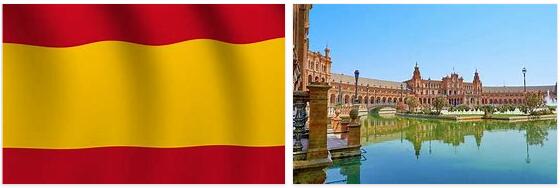Spain is located in the southwest of Europe and occupies approximately 85% of the territory of the Iberian Peninsula, as well as the Pitius and Balearic Islands in the Mediterranean Sea, the Canary Islands in the Atlantic Ocean. Under the control of Spain are the cities of Ceuta and Melilla (in Morocco) and the islands of Velez de la Gomera, Alusenas and Chafaranas. In the east and south, the country is washed by the Mediterranean Sea, in the west – by the waters of the Atlantic Ocean. Spain is located at the crossroads of important sea and air routes connecting Europe with the African and American continents.
MAJOR CITIES:
Barcelona is the capital of Catalonia, a city that cannot be forgotten once you have been here at least once. All sorts of styles and eras are mixed in the diverse and unique architecture of this world-famous city. In the center is the famous, full of proud antiquity, Barrio Gotico – a Gothic quarter, the highest point of which is the Acropolis of Barcelona, there is also a cathedral that was erected over six centuries. Sagrada Familia is one of the most incredible and fantastic buildings of the 20th century, which has become an unofficial symbol of today’s Barcelona, one of Gaudí’s great creations.
Madrid – the capital of Spain – is a city where the comfort and charm of the center with small streets, squares and many architectural monuments are harmoniously combined with modern areas, their wide avenues and high-rise buildings. In the center, be sure to walk along the pedestrian streets, including in your itinerary a visit to the three historical squares of Madrid – the Main Square (Plaza Mayor), the central square “Gate of the Sun” (Puerta del Sol) and Plaza de España (Plaza de Espana) with a monument to Don Quixote and Sancho Panso. The Prado Museum will captivate you in past centuries with the masterpieces of great artists – Velasquez, Goya, Picasso.
RELIGION: Catholics – 97%, Protestants, Jews, Muslims
MONEY: EURO. Coins in denominations of 1.2, 5, 10, 25, 50 cents and banknotes in denominations of 5, 10, 20, 50, 100, 200, 500 are used in circulation. Currency can be exchanged at banking institutions, hotels and exchange offices. In major cities there are ATMs where you can use VISA, MASTER KARD, AMERICAN EXPRESS credit cards.
CLIMATE: According to Bridgat, there are three types of climate in Spain: temperate maritime in the northwest and north – with moderate temperatures and heavy rainfall throughout the year; Mediterranean in the south and the Mediterranean coast – with mild, wet winters and hot, dry summers; continental climate in the interior of the country – with cool winters and warm dry summers. The best time for tourism is from late spring to early autumn. Ski resorts in Spain operate all year round.
EXCURSIONS: We recommend booking individual excursions with Russian-speaking guides in advance.
KITCHEN: Modern Spanish cuisine is diverse, its formation was influenced by the Romans and Moors, later by the Americans. The original Spanish cuisine, in essence, is simple in a peasant way. Its basis is onion, garlic, sweet pepper and herbs. Spices are used sparingly, but saffron is plentiful. It is impossible not to mention tapas – a variety of Spanish snacks. In any tavern or coastal cafe, they are served at any time of the day or night – with beer, wine, cider or as a snack before dinner. Of the first courses, cream soups, such as semolina cream soup with almonds, are the most popular in Spain. Cream soup tastes like our dressing soups. The meat second course is usually stewed or grilled. Along with beef, veal, pork and young lamb, poultry dishes are also popular among the Spaniards.
It is impossible not to mention paella – a truly Spanish dish that is prepared from rice with the addition of many ingredients – in different regions in different ways – from chicken to oysters, shrimp and vegetables. Of the desserts, the most popular are puddings, in addition, the Spaniards love sweet pies stuffed with almond cream. They prefer natural red wines (vintage Spanish wines can compare with the famous French ones), mineral water.
SHOPPING: Store hours are from 9.00 to 13.00 and from 16.00 to 20.00. Saturdays usually until 13.00. During the tourist season, shops in coastal towns may close much later than usual. Large department stores often operate non-stop. Sunday is a day off. In large stores, when buying imported goods for an amount exceeding 40 Euros, you can apply for a tax free coupon. At the customs, upon presentation of this coupon in a special window, you will be refunded the amount of tax paid by you when purchasing the goods.
Tipping: The tipping system applies to the services of waiters in bars and restaurants, maids in hotels, taxi drivers and guides and amounts to 5-10% of the order value. Tipping is optional, but if the customer is satisfied with the service, a tip is a sign of good manners.
COMMUNICATIONS: It is much cheaper to use the booths and payphones of “Telefonica” (Spanish telephone company) than to call from a hotel. Coins or telephone cards (Tarjeta telefonica) are used for payment, which can be purchased at the hotel or at tobacconists. To access international communication – 00, beep, country code (for Russia – 7) of the city, the number of the called subscriber. One minute of conversation with a subscriber in Russia from a street pay phone costs about 0.75 Euro. Prices for telephone communication in call centers can vary significantly.
Useful telephone numbers: National police – 091, local police – 092, Cruz Roja (Red Cross) – 22-22-22, emergency medical assistance – 061, fire department – 080, exact time service – 093, information service about city streets, traffic buses, duty pharmacies, etc. – 098.
MAINS VOLTAGE: 50, 100 and 220 volts AC.
